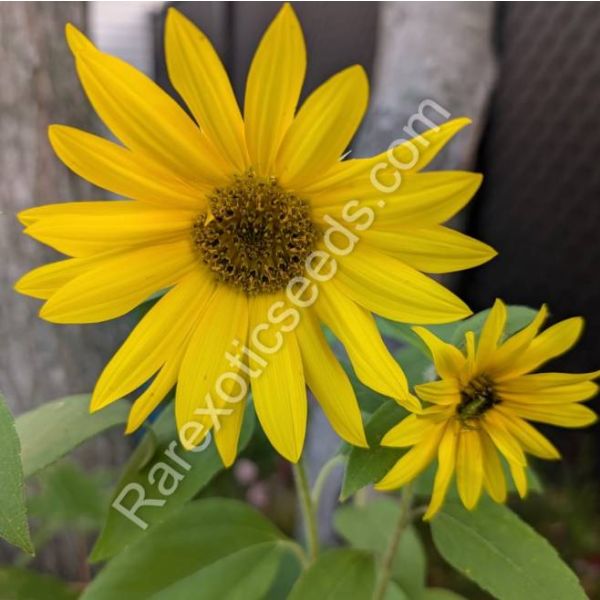Graines Helianthus Giganteus (Graines Tournesol Géant)
Graines Helianthus Giganteus (Graines Tournesol Géant)
Si vous recherchez le plus grand et le plus gros tournesol, vous l'avez trouvé !

Delivery
All orders shipped with UPS Express.
Always free shipping for orders over US $250.
All orders are shipped with a UPS tracking number.
Returns
Items returned within 14 days of their original shipment date in same as new condition will be eligible for a full refund or store credit.
Refunds will be charged back to the original form of payment used for purchase.
Customer is responsible for shipping charges when making returns and shipping/handling fees of original purchase is non-refundable.
All sale items are final purchases.
Help
Give us a shout if you have any other questions and/or concerns.
Email: contact@domain.com
Phone: +1 (23) 456 789
Availability: En stock
SKU
Helianthus Giganteus
Le Helianthus Giganteus ou le tournesol géant est un pluriannuel répartit en zone 3 mais est généralement développé comme un annuel. Si vous recherchez le plus grand et le plus gros tournesol, vous l'avez trouvé ! Atteignant jusqu'à 16 pieds, ces floraisons énormes font des fleurs parfaites pour la compétition. Les fleurs colossales sont soutenues sur des pieds vigoureux avec de grandes feuilles.
Cette espèce supporte des fleurs géantes aux fleurons de couleur jaune-clair à or. Ils ont de grandes feuilles raides, velues, et quelque peu collantes. Les fleurs jaunes doré avec de plus petites fleurs brunes en composent le centre. Ces très grands tournesols peuvent mesurer de 12-14 pieds ou plus. La tête de graines mesure jusqu'à 15 po de diamètre ou plus et est recouverte dune multitude de graines de tournesol. Les plants fleurissent à partir de Juillet jusqu’en Septembre.
Ces tournesols sont audacieux, beaux et faciles à cultiver. Le tournesol géant est employé commercialement pour l'huile de cuisine et la margarine, et même comme pétrole de voiture. À l'origine les Indiens d’Amérique les utilisaient pour leur huile, en farine et comme colorant.
Zones de rusticité :
3-9 (- 37c/-35f, -5c/25f). Le Helianthus Giganteus préfère un endroit ensoleillé dans un sol bien-draine, et ils sont très tolérants de la sécheresse et des sols pauvres. Si les plants sont plantés à l’ombre partielle, le jalonnement peut être nécessaire pour les soutenir, ou les plants peuvent être pincés à la plantation pour favoriser l'embranchement.
| Nom commun | Giant Sunflower |
|---|---|
| Espèce | Helianthus giganteus |
| Germination | Sow the seeds outside from March to May. You can also sow indoors at a temperature around 68-86ø (will germinate over a wide temperature range). Sow those 2-3 weeks before planting out. Sow at a depth of 4 times the size of the seed, and expect germination in 5-10 days. Transplant seedlings when there have, at least, two sets of true leaves. Grow on at 70-75øduring the day and 65-68ø at night. Once they get bigger, plant them out at 2-4 feet apart, in full sun and in a light soil. The seeds can be sown outdoors after last frost, but remember: they are a favorite food of birds and rodents and may be eaten by them! Germination can take longer. Be patient! Notes: What is usually called the flower is actually a head (formally composite flower) of numerous flowers (florets) crowded together. The outer flowers are the ray florets and can be yellow, maroon, orange, or other colors, and are sterile. The florets inside the circular head are called disc florets. The disc florets mature into what are traditionally called "sunflower seeds", but are actually the fruit (an achene) of the plant. The true seeds are encased in an inedible husk. Sunflowers in the bud stage exhibit heliotropism. At sunrise, the faces of most sunflowers are turned towards the east. Over the course of the day, they move to track the sun from east to west, while at night they return to an eastward orientation. This motion is performed by motor cells in the pulvinus, a flexible segment of the stem just below the bud. As the bud stage ends, the stem stiffens and the blooming stage is reached. Now the stem is frozen, typically in an eastward orientation. The stem and leaves lose their green color. The wild sunflower typically does not turn toward the sun; its flowering heads may face many directions when mature. However, the leaves typically exhibit some heliotropism. |
| Price View | Tranche de prix |

